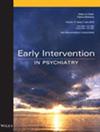Dissociation is associated with clinical severity, increased risk of suicide and self-harm, and disproportionately affects adolescents and young adults. Whilst evidence indicates multiple factors contribute to dissociative experiences, a multi-factorial explanation of increased risk for dissociation has yet to be achieved.
We used multiple regression to investigate the relative influence of five plausible risk factors (childhood trauma, loneliness, marginalisation, socio-economic status, and everyday stress), and machine learning to generate tentative high-risk profiles for ‘felt sense of anomaly’ dissociation (FSA-dissociation) using cross-sectional online survey data from 2384 UK-based 16- to 25-year-olds.
Multiple regression indicated that four risk factors significantly contributed to FSA-dissociation, with relative order of contribution: everyday stress, childhood trauma, loneliness and marginalisation. Exploratory analysis using machine learning suggested dissociation results from a complex interplay between interpersonal, contextual, and intrapersonal pressures: alongside marginalisation and childhood trauma, negative self-concept and depression were important in younger (16–20 years), and anxiety and maladaptive emotion regulation in older (21–25 years) respondents.
Validation of these findings could inform clinical assessment, and prevention and outreach efforts, improving the under-recognition of dissociation in mainstream services.



